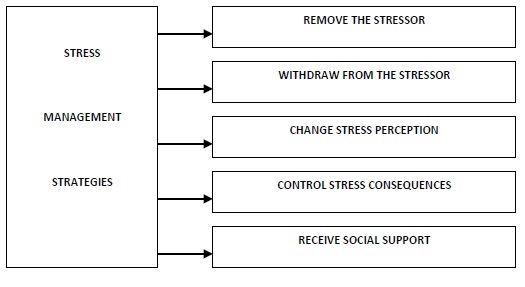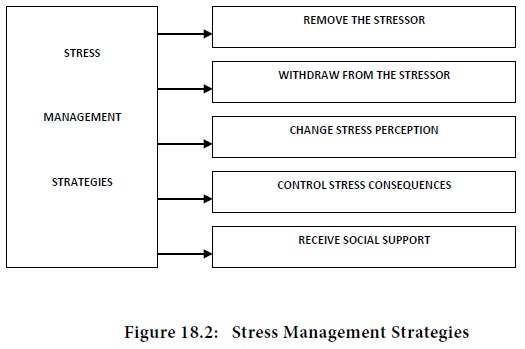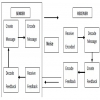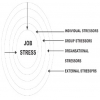Home | ARTS | Management Concepts & Organisational Behaviour
|
Managing Work-Related Stress - Stress Management
Management Concepts & Organisational Behaviour - Stress Management
Managing Work-Related Stress - Stress Management
Posted On :

In managing work related stress, both the organization and the employees have joint responsibility.
Managing Work-Related
Stress
In managing work related stress, both the organization and the employees have joint responsibility. Stress management often includes several strategies. These are shown in the following diagram.

An important way companies can effectively manage stress is by removing the stressors that cause unnecessary tension and job burnout. Other stress management strategies may keep employees. “Stress-fit”, but they don’t solve the fundamental causes of stress.
In managing stress, organizations have to investigate the main causes of stress in their workplace. For example, you may ask employees to complete confidential questionnaires to identify when and how they experience stress. You may remember that one of the most powerful ways to remove workplace stressors is to empower employees so that they
The most common work-life balance initiatives are flexible work time, job sharing, telecommuting, personal leave programs, and childcare support. Many firms have flexible timings with regard to the hours, days, and amount of time employees want to work.
Job sharing splits a career position between two people so that they experience less time-based stress between work and family. They typically work different part of the week, with some overlapping work time in the weekly schedule to coordinate activities.
Telecommuting reduces the time and stress of commuting to work and makes it easier to fulfill family obligations, such as temporarily leaving the office to pick up the kids from school. Research suggests that telecommuters experience a healthier work-life balance. Employers with strong work-life values offer extended maternity, paternity, and personal leaves to care for a new family or elderly parents who need assistance. Childcare support reduces stress because employees need not rush to drop off their children and less worried during the day about how well they are doing.
Removing the stressor may be an ideal solution, but that is not always possible. An alternative strategy is to permanently or temporarily take employees away from the stressor. Permanent withdrawal occurs when employees are transferred to other jobs.
You have earlier learnt that employees experience different levels of stress in the same situation because of their perceptual differences. Therefore, changing perceptions of the situation can minimize stress.
Managing workplace stress also involves controlling its consequences. Research studies show that physical exercise reduces the physiological consequences of stress by helping employees lower their respiration, muscle tension, heartbeat and stomach acidity. Beyond fitness programs, some companies offer wellness programs that educate and support employees in terms of better nutrition and fitness, regular sleep, and other healthy habits. Another way to control the physiological consequences of stress is through relaxation and meditation.
Now-a-days many large firms offer employee assistance programs in the form of counseling services that help employees overcome personal or organizational stressors and adopt more effective coping mechanisms. Personal problems and family problems are solved through these programs. Employee assistance programs can be one of the most effective stress management interventions where counseling helps employees understand the stressors, acquire management skills and practice those skills.
Receiving social support from co-workers, supervisors, family, friends, and others is one of the more effective stress management strategies. Social support refers to the person’s interpersonal transactions with others and involves providing either emotional or informational support to buffer the stress experience.
In managing work related stress, both the organization and the employees have joint responsibility. Stress management often includes several strategies. These are shown in the following diagram.

Remove the Stressor
An important way companies can effectively manage stress is by removing the stressors that cause unnecessary tension and job burnout. Other stress management strategies may keep employees. “Stress-fit”, but they don’t solve the fundamental causes of stress.
In managing stress, organizations have to investigate the main causes of stress in their workplace. For example, you may ask employees to complete confidential questionnaires to identify when and how they experience stress. You may remember that one of the most powerful ways to remove workplace stressors is to empower employees so that they
Family-Friendly and Work-Life initiatives
The most common work-life balance initiatives are flexible work time, job sharing, telecommuting, personal leave programs, and childcare support. Many firms have flexible timings with regard to the hours, days, and amount of time employees want to work.
Job sharing splits a career position between two people so that they experience less time-based stress between work and family. They typically work different part of the week, with some overlapping work time in the weekly schedule to coordinate activities.
Telecommuting reduces the time and stress of commuting to work and makes it easier to fulfill family obligations, such as temporarily leaving the office to pick up the kids from school. Research suggests that telecommuters experience a healthier work-life balance. Employers with strong work-life values offer extended maternity, paternity, and personal leaves to care for a new family or elderly parents who need assistance. Childcare support reduces stress because employees need not rush to drop off their children and less worried during the day about how well they are doing.
Withdraw from the stressor
Removing the stressor may be an ideal solution, but that is not always possible. An alternative strategy is to permanently or temporarily take employees away from the stressor. Permanent withdrawal occurs when employees are transferred to other jobs.
Change stress perceptions
You have earlier learnt that employees experience different levels of stress in the same situation because of their perceptual differences. Therefore, changing perceptions of the situation can minimize stress.
Control the consequences of stress
Managing workplace stress also involves controlling its consequences. Research studies show that physical exercise reduces the physiological consequences of stress by helping employees lower their respiration, muscle tension, heartbeat and stomach acidity. Beyond fitness programs, some companies offer wellness programs that educate and support employees in terms of better nutrition and fitness, regular sleep, and other healthy habits. Another way to control the physiological consequences of stress is through relaxation and meditation.
Employee Assistance Programmes
Now-a-days many large firms offer employee assistance programs in the form of counseling services that help employees overcome personal or organizational stressors and adopt more effective coping mechanisms. Personal problems and family problems are solved through these programs. Employee assistance programs can be one of the most effective stress management interventions where counseling helps employees understand the stressors, acquire management skills and practice those skills.
Receive Social Support
Receiving social support from co-workers, supervisors, family, friends, and others is one of the more effective stress management strategies. Social support refers to the person’s interpersonal transactions with others and involves providing either emotional or informational support to buffer the stress experience.
Social support reduces stress in
at least three ways. First, employees
improve their perception that they are valued and worthy. This, in turn,
increases their self-esteem and perceived ability to cope with the stressor. Second, social support provides
information to help employees interpret, comprehend,
and possibly remove the stressor. Finally,
emotional support
Tags : Management Concepts & Organisational Behaviour - Stress Management
Last 30 days 889 views














